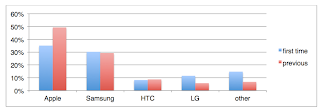This picture is the key result:
It shows that iPhone is attracting close to 50% buyers among those who have owned a smart phone previously, a comfortable leading position. But among the first-time smart phone buyers, not so much. The reporter put it in a rather negative light. We think it's not so bad.
Today, a CIRP report shows that 20% of iPhone users switched from Android phone users, whereas only 7% of Samsung phone buyers switched from iPhone. This helps to explain the picture above: Apple is very good at converting experienced smart phone users who want and can afford a better phone.
Given the proliferation of Android phones, which has been pushed by makers from Samsung to HTC to LG to Huawei to Lenovo to Xiaomi and others at cost or below cost, what would be the best strategy for Apple to deepen its conversion?
Is it better to use the older versions of iPhone, or is it at the point that Apple can do better with a new lower-cost iPhone? The answer is probably the latter.
Ever since AllThingD broke the "news" on August 10 that Apple is going to announce both iPhone 5S and iPhone 5C on Sept. 10, 2013, the rumor has been widely repeated and the expectation has set in. Today, Wall Street Journal claimed to have confirm it. If this is true, Apple has clearly decided that a lower-cost new iPhone is the way to deepen the conversion. This is both timely and an important strategic departure. We can see the following advantages of launching a new and lower-cost iPhone.
1. iPhone 5C would work hand-in-hand with the strategy of partnering with China Mobile.
2. It creates a high-end destination point for the group of low-budget users who cannot afford iPhone 5 or iPhone 5S, but would like to have the iOS experience. This is probably based on the recognition that there emerges two broad group of smart phone users: those at the high end and those who are more cost sensitive. Apple wants to be the high-end destination for both groups.
3. iPhone 5C is using the iPhone 5 spec, and newer technologies than iPhone 4. This helps to compete with other cheap phones that have newer form factors and technologies.
4. Apple can better control the costs with a new design. And possibly more importantly the new design allows a substantial differentiation from the flag-ship design, so that it serves to extend the iPhone brand but not cheapen it.
5. With this, Apple can continue to enjoy saving part of the education costs for first-time users and keep a healthy margin for its iconic device, extending the brand as well as the iOS ecosystem.
The media are too focused on market shares and seldom ask if a bigger market share makes sense at all if all it does is making sales but not profits. With the iPhone 5C out soon, it seems what competitors have done at the low-end is little more than preparing an educated customer base for Apple to convert.
Could it be that simple? We'll just have to wait and see.
=============================================
Here are some survey results since the new iPhones were launched.
